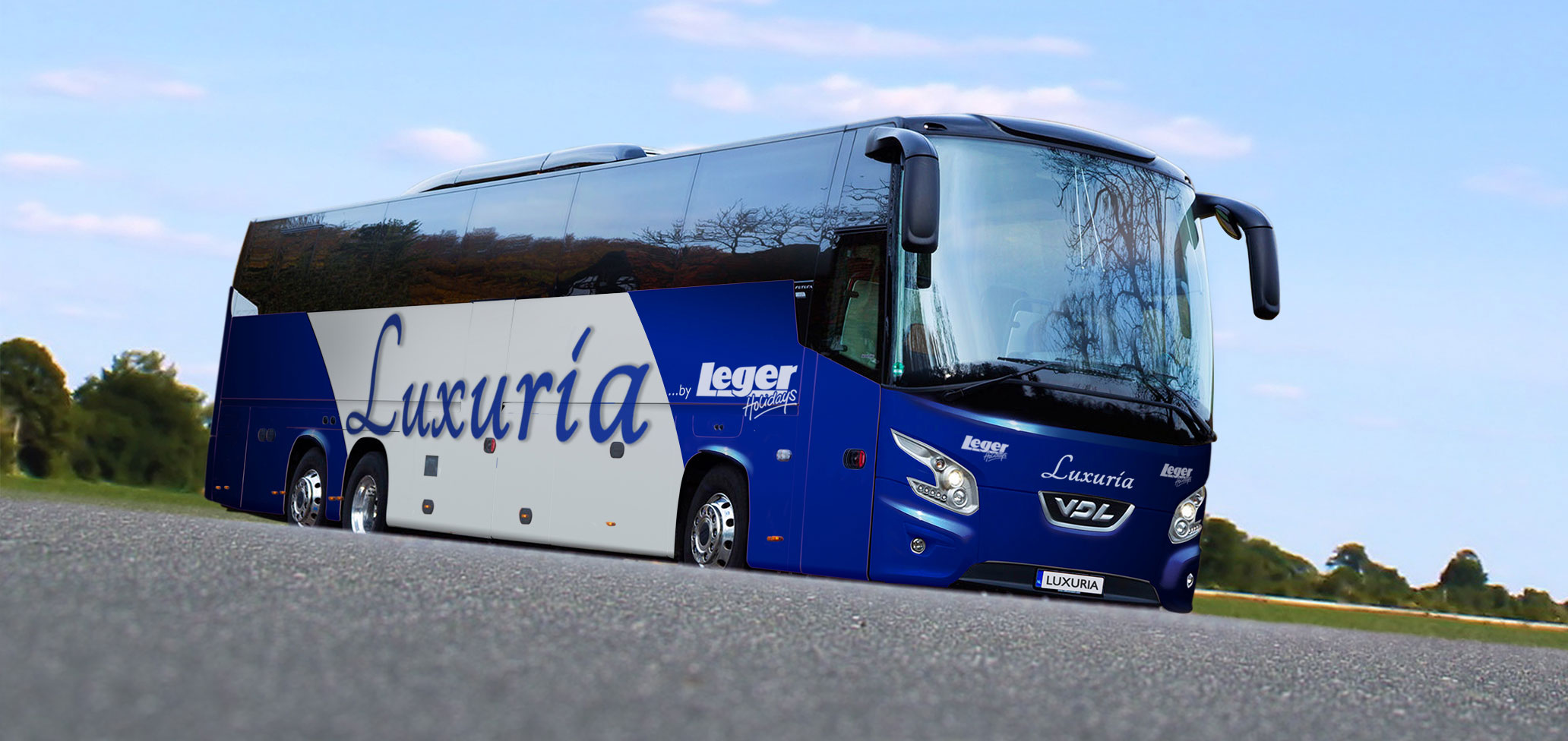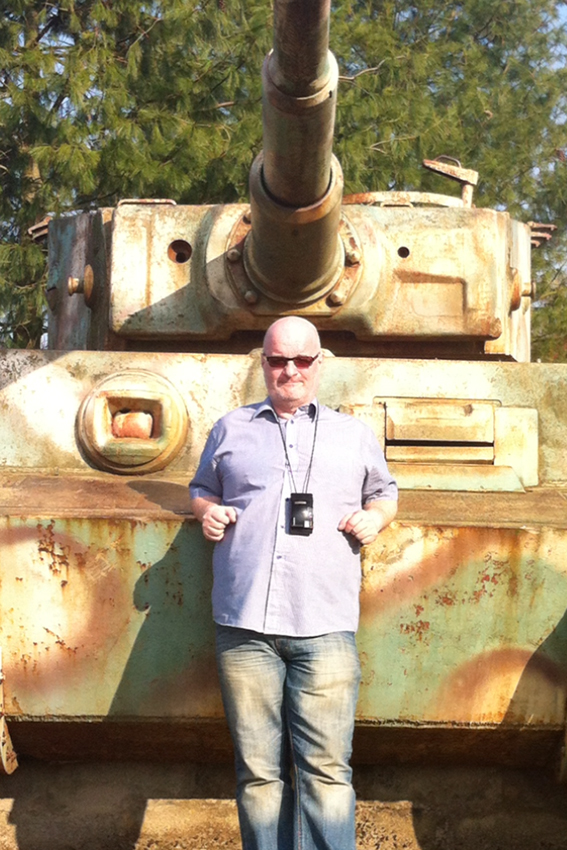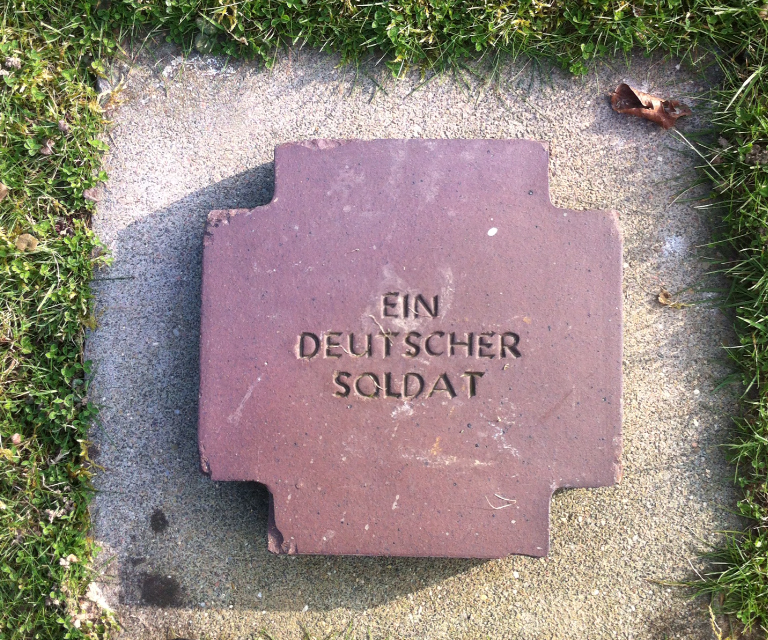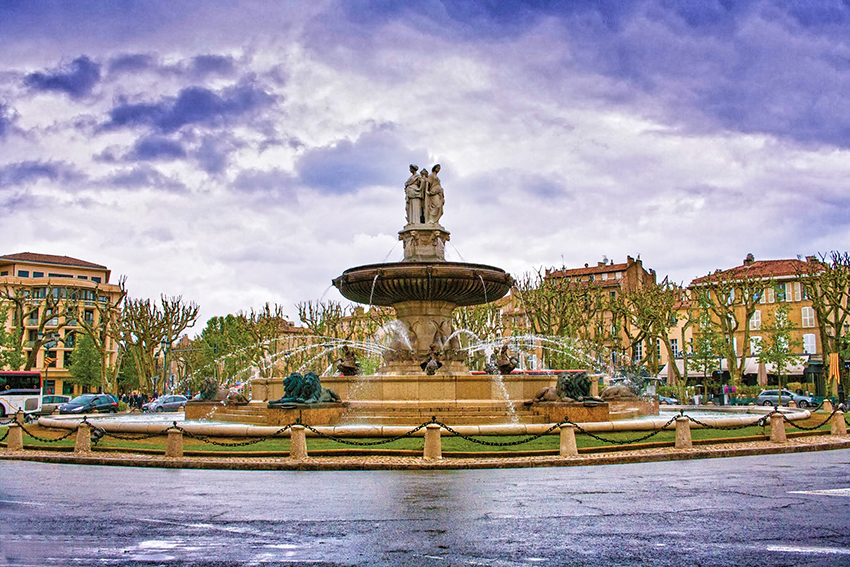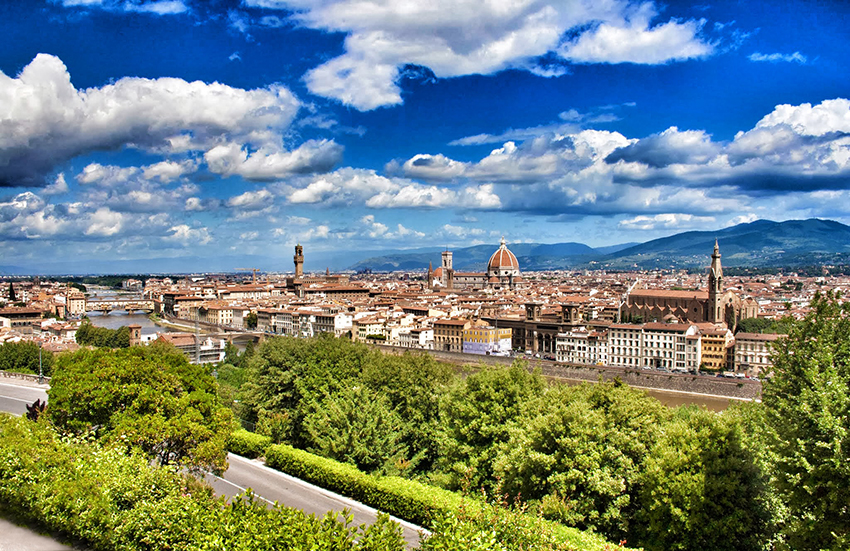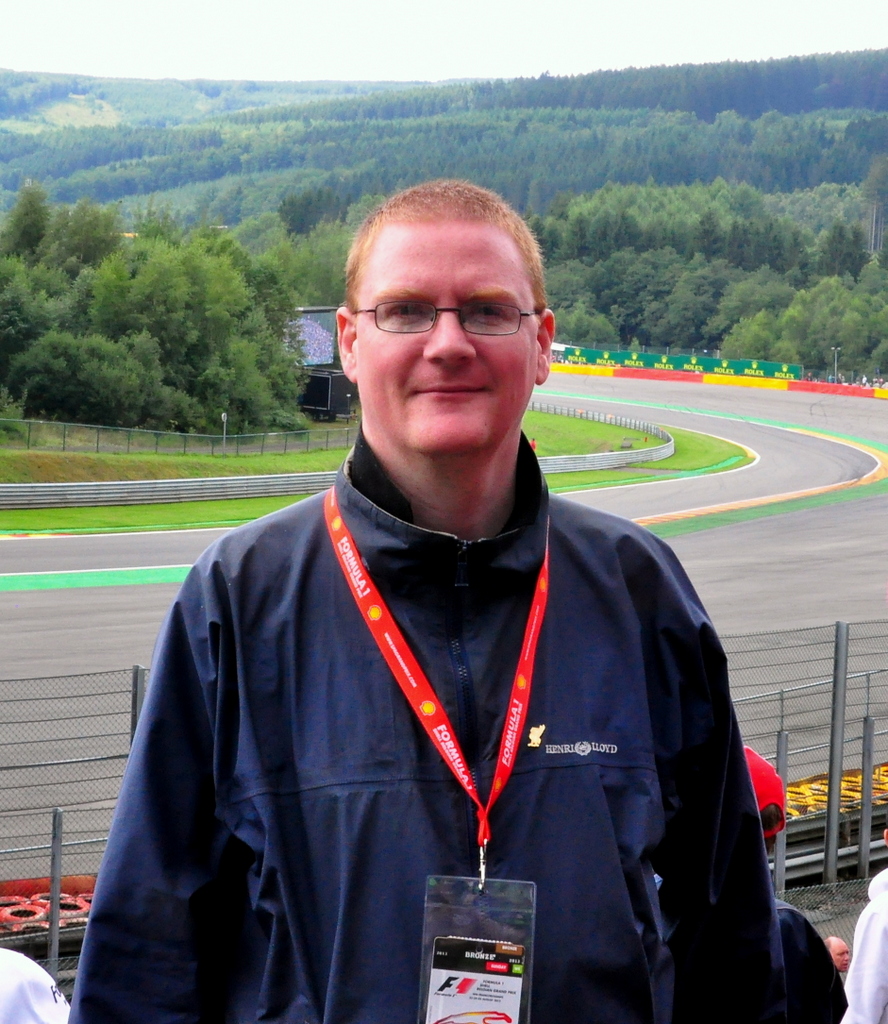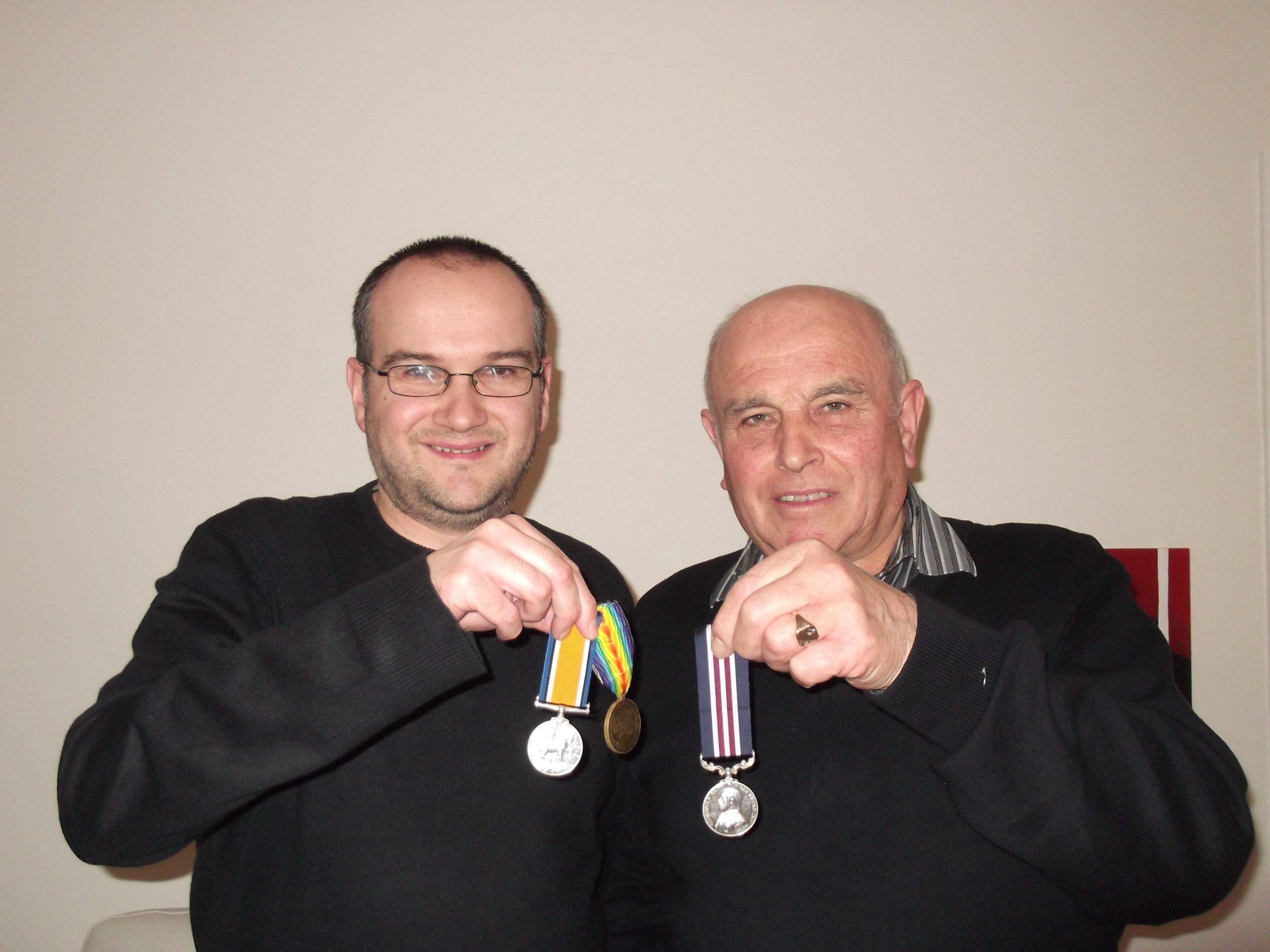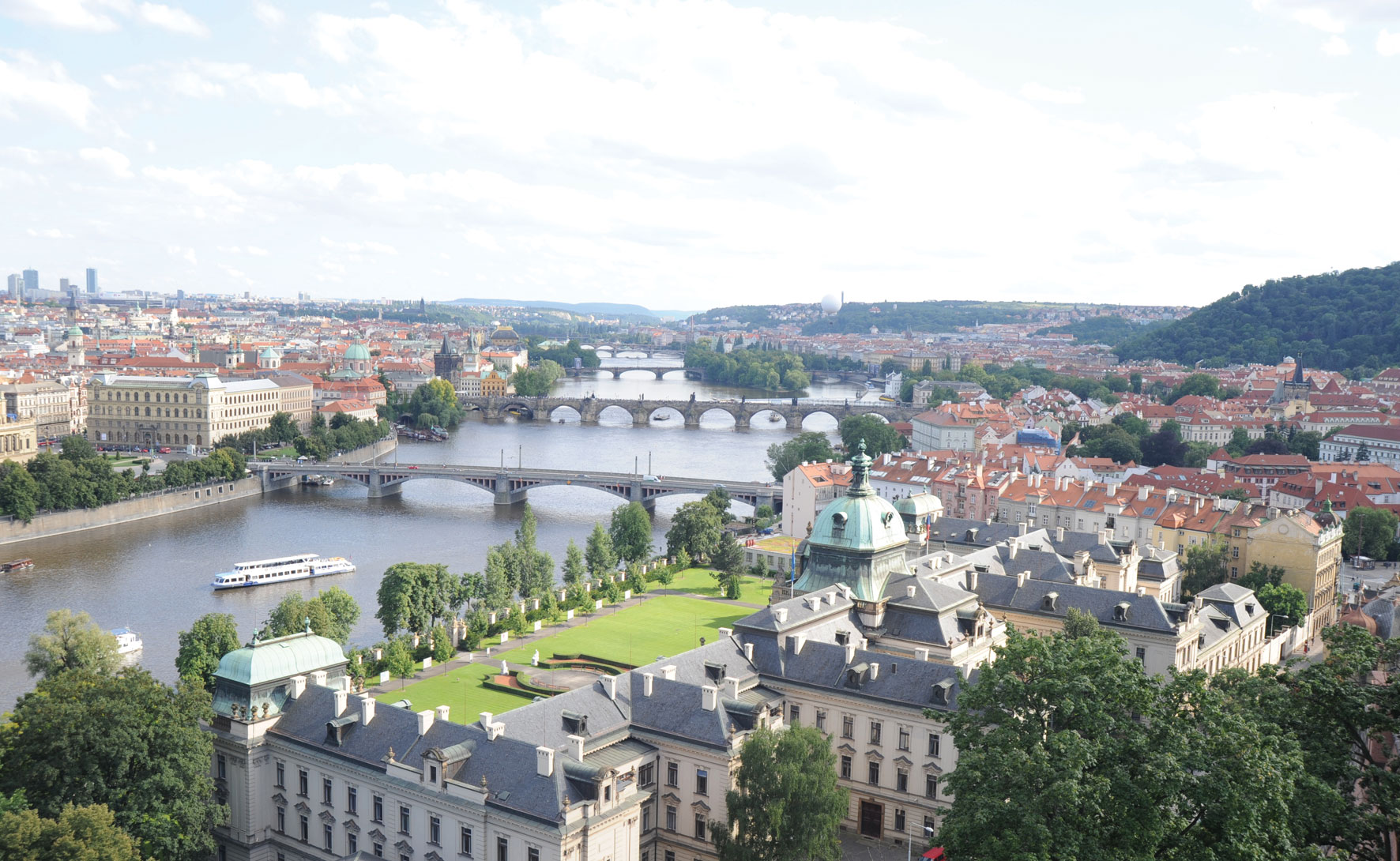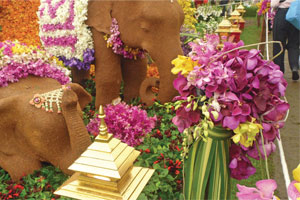Leger Holidays are proud to present our NEW and innovative Luxuria coach.
In 2003 when we first introduced Silver Service we set the standard for added comfort and style when travelling across Europe. Many of you have been asking “What next?”…the answer is Luxuria – the next level in escorted touring travel.
Luxuria takes coach travel to the next level of comfort, it only seats 31 passengers in rows of three, meaning significantly wider seats and extra leg room.
The deluxe armchair-style seats, some with tables, also feature retractable calf rests, fully-interactive personal touch screen TV’s, offering a wide choice of movies, T.V programmes and music so you can watch what you want when you want.
For added comfort there are cup holders along with USB and UK plug charging points. Refreshments are also available on board and porterage is offered at most hotels.

Another standout feature of Luxuria is the selection of double and single seats, including four seats face to face with tables. On each row there are just three seats rather than the usual four, meaning each armchair-style luxury seat is wider and with more personal space around it for a more comfortable journey. And with up to 7 single seats available, these are likely to be very popular with single travellers and those who enjoy their own personal space.
For more information regarding the new service and the tours Luxuria will feature on please visit our dedicated website page here.
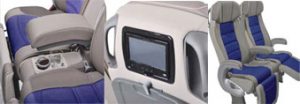
A battlefields tour and a journey to a 'free Europe'
Paul Prendergast shares his experience of the D-Day Landings in Normandy tour, his second Battlefields tour with Leger.
DAY 1
The first day of our Battlefields tour started with a noon pick up at Pease Pottage service station. It was a smooth journey down to Dover where we had the changeover onto our coach onward to the Battlefields of Normandy. Whilst at Dover I had the chance to have a quick chat with Paul Reed, the Leger Head Battlefields Guide – this man is without a doubt a great Military Historian and his knowledge is boundless. It was a real pleasure to meet him and shake his hand. We arrived in Calais with no problems. On the four-hour drive to the beaches of D-Day the journey was quick and pleasant and Mark and Dave – our drivers – were friendly, smart and willing to help. Our guide for the trip was Bill McQuade. He told us what to expect on each day of the tour. Again, his military knowledge was boundless and he answered any questions with no problems.
DAY 2
We set off at 08.30am to Pegasus Bridge. It was great to actually walk on the bridge – just to think, this was the point that the heroes started to fight to free Europe and get back the freedom to the people of France. We also went to visit the Gondrée Café which was the first place to be liberated in France. I found it quite remarkable that a small band of men risked so much on this bridge. We stopped for lunch at a small café just next to the bridge before going to Sword Beach – Queen’s sector. This is where the British landed. We also stopped to see a statue of a piper who led the soldiers into battle playing – this was at Hermanville which is twinned with Tangmere in West Sussex where a Battle of Brittan RAF squadron was based. We then visited the Juno Sector of the beach which is where the film D–Day was actually made and then went to see a memorial to the 7000 Canadians that landed on the beach, before moving on to the Juno Centre – a fantastic place to look around at pictures and artifacts. I sat in a small cinema with a small group of people from our group and also a group of children from Canada. The film showed actual battlefield dead and casualties, and as we left the cinema I found some of the children crying. I asked if they were OK and one of them told me that it had brought it home to them what really happened. I found it quite touching that children from today realise what these men gave up. We then visited an underground bunker which was in very good condition – it still had the small stove and cots in it. We then went to Mulberry B. We couldn’t see a lot due to the mist on the sea, and can only imagine how it was on 6th June 1944.
DAY 3
Our day began with a very misty drive down to Bloody Omaha, the American sector of the D-Day landings. We started our day at the American War Cemetery at Omaha. I have never visited any other cemeteries apart from the British ones and I didn’t know what to expect. On arrival there were immaculate white headstones as far as the eye could see. Buried in this place are a few people who I would like to mention: Robert A Niland, killed 06/06/44 and Preston Niland, killed 07/06/44 – two brothers killed within a day of each other and on whom the film Saving Private Ryan is based. Also, Theodore Roosevelt Jnr., killed 12/07/44, son of the American President.
Walking around this place bought chills to me and brought home the price that these men paid for my freedom today. Then it was on to the Overlord Museum. This had some fantastic pieces of kit in it to look at close up, ranging from a Panzer Tank to Sherman Tank and personal belongings of British and American soldiers. We then went down onto the actual Omaha Beach. I can’t imagine the mayhem and slaughter the Americans must have gone through on the landing day. I went up a small path which lead to a small German bunker which likely held a machine gun because of the vantage point down on to the beach. We then went to Utah Beach to a fantastic little place where you could have look around and actually see what happened on the day. My favourite part of Utah Beach was when I found a few German bunkers that you could actually go into. We then stopped at a statue of Dick Winters – he was one of the Band of Brothers. We stopped at a tribute to the 101 Airborne Division, otherwise known as Easy Company, made famous by a TV series by Stephen Spielberg.

The last trip of the day was to a German War Cemetery. I didn’t know how I would feel about this because I’ve never visited one before. It contained about 8000 soldiers of all ranks. What was also shown to me by our guide was the grave of Michael Wittmann and his tank crew. He was one of the most daring commanders of his time and he died and was buried with his crew. I walked around the cemetery and noticed no headstone standing upright and the lack of flowers on any graves. I asked Bill, our guide, why this was. He said it was that a ‘Spirit of the Forest’ approach is taken to death in Germany, hence the lack of flowers – only firs and ferns on some graves. In the British cemeteries, any soldier that is not known and buried is marked with the words ‘Known But To God’. Here nothing. All it said was Ein Deutscher Soldat – A German Soldier. I found it simple but quite touching. A very thought-provoking end to the day.
Day 4
We set off on another misty day to visit Jerusalem Cemetery, a very small place with only 48 buried at the cemetery. I found a grave of J Banks DLI who died on the 21st July 1914 aged just 16. How can a child die like that because he wanted to do the right thing for King and Country? We stopped to take some photographs of a memorial to the 49th West Riding Division and then onto the Scottish Corridor and Hill 112 to look at a Cromwell tank. Unfortunately, we couldn’t see much from the top of the hill due to the mist. We stopped off in a town called Falaise for lunch – this town is famous for being the town where William the Conqueror was conceived – before going to Mont Ormel, known as The Polish Battlefield. We also went to a small but fantastic museum which had great artifacts and also a fantastic view of where the German retreat took place. The group’s last stop was at a National French monument which is a tiger tank abandoned by its crew. We had a group photo taken by Bill.
The thoughts on my first Leger WW2 trip? Simply fantastic. Our guide, Bill McQuade’s knowledge was amazing and all our questions were answered. His passion for his subject is simply wonderful. Our drivers, Mark and Dave were safe drivers, always helpful and well turned out. With the 70th anniversary of D-Day fast approaching, I would recommend this trip without a doubt.
This was my second trip with Leger in under six months – my first was All Quiet on the Western Front – and I’ve enjoyed them both. Which one next? Verdun? Fritz? Tommy? Who knows, but whichever one I book, I know it will be great.
Lose yourself in Cézanne ’s home town.
Known for its many fountains, famous artists and impressive architecture, next stop on my tour of Provence and the Dordogne was the charming town of Aix en Provence.
It was raining heavily as I stepped onto the streets of Aix en Provence, a town no stranger to water being known as the ‘City of a Thousand Fountains’, the water coming from the city’s underground springs. One of the first things I saw was… a fountain: the fountain of La Rotonde to be exact, built in 1860, and a sight I spotted on many postcards throughout my visit. As I walked along the street, following my map in the direction of a street named ‘Cours Mirabeau’, people dashed around shielding from the weather under brightly-coloured umbrellas or were sheltering in doorways or in the haven of one of the cosy cafés. I passed one old lady wearing a carrier bag on her head – stylishly, of course, it was the south of France afterall. She’d obviously not anticipated such a heavy downpour today.
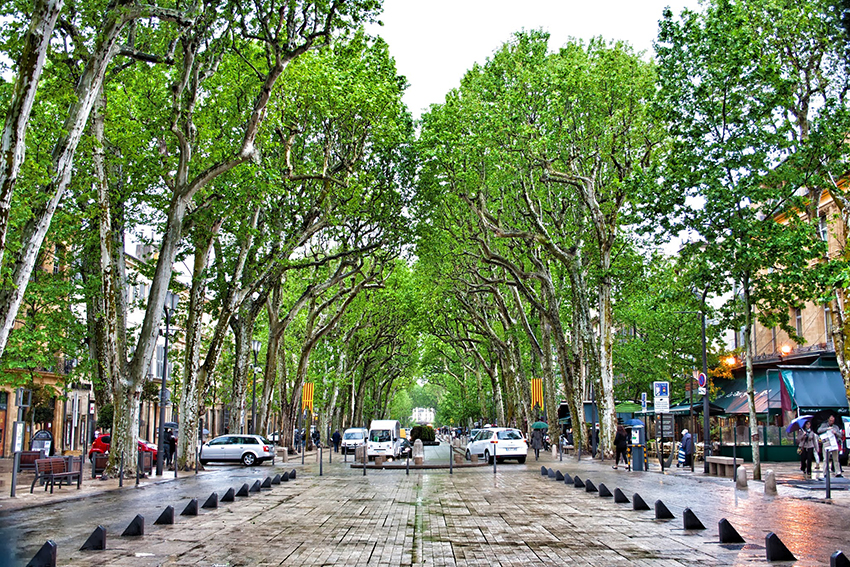
After a couple of minutes I reached the wide avenue of Cours Mirabeau. One the right-hand side, banks and other businesses filled the old buildings, while to my left, inviting cafés, book stores and gift shops lined the street. Continuing along, I came across one of Aix’s thousand fountains: a moss-covered font known as the Fontaine des Neuf Canons (the Fountain of the Nine Cannons), apparently located on the site of a spring where sheep were once brought to drink while migrating. Further along, I spotted another mass of thick, green moss hiding another fountain known as the ‘mossy fountain’ – the Fontaine Moussue, a thermal fountain whose water comes from a hot natural spring.
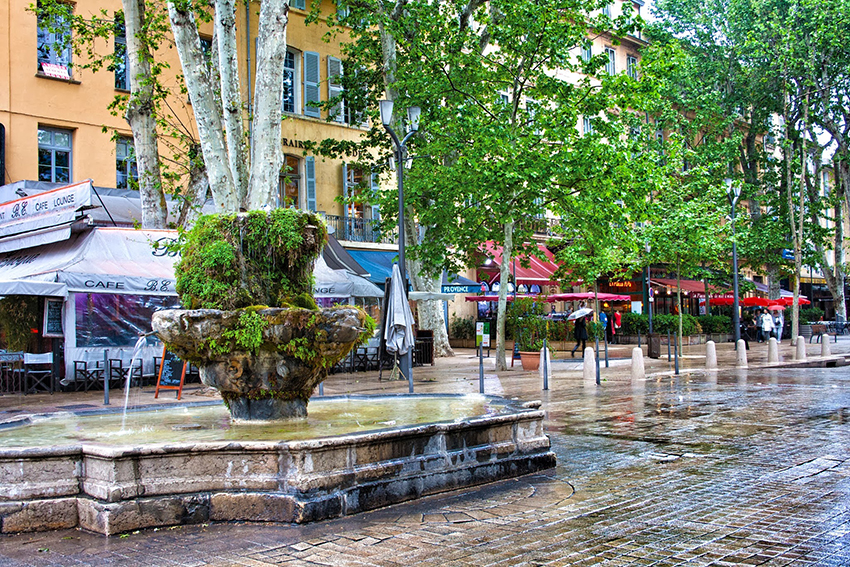
The reflection of car headlights danced across the wet, glossy pavement as I carried on along the avenue, framed by huge sycamore trees (or plane trees as they’re sometimes referred to), and there on the left was a café called Les Deux Garçons. I’d read about this place before my trip, and knew it as the legendary brasserie frequented by the likes of Edith Piaf, Ernest Hemmingway, Winston Churchill, Paul Cézanne and his friend, novelist Émile Zola. It was in fact here in Aix en Provence that the great painter Paul Cézanne was born in 1839. It was a name I remembered from my Art History studies, many years ago, and as I walked along, on the pavements I noticed small brass medallions underfoot which displayed his name and a large letter ‘C’. These plaques mark around 30 significant places associated with the painter’s life, making up the ‘Cézanne Trail’ which starts at the bronze statue of Cézanne standing just outside the Tourist Office and opposite the Fontaine de la Rotonde. The statue was put there in 2006 marking the centenary of the artist’s death. The trail features sites such as the College Mignet (then known as Bourbon College) which is where Cézanne met Zola; the building where Cézanne was born and, of course, the Café des Deux Garçons at No. 53 Cours Mirabeau.
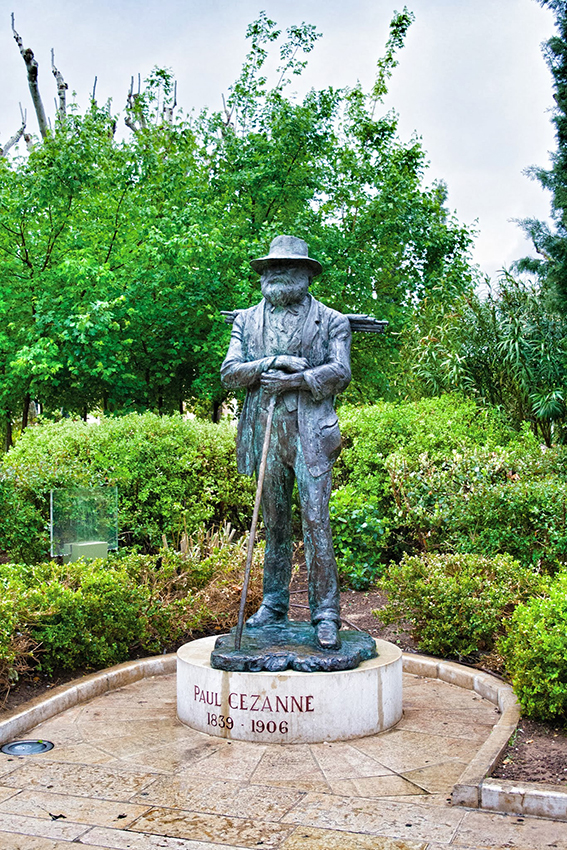
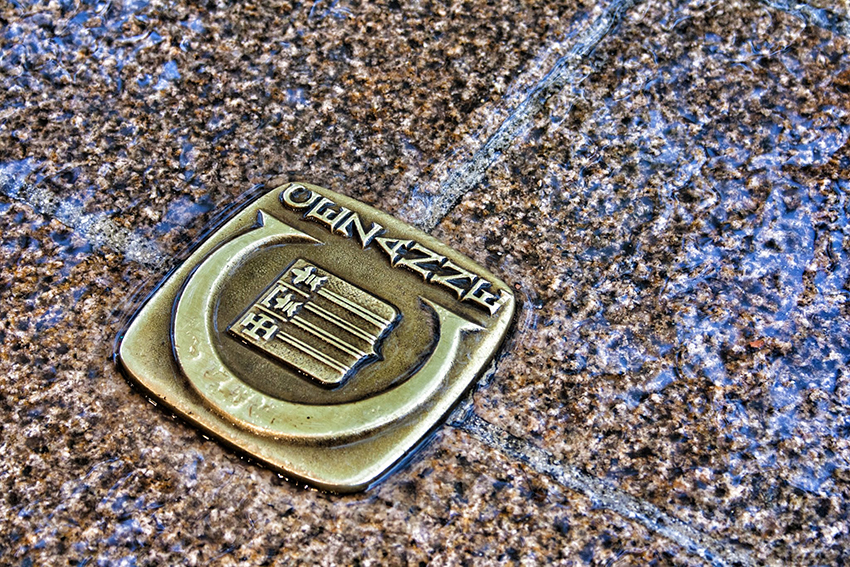
Splashing through puddles my feet became more and more soggy as I became more and more engrossed in what I was seeing than where my feet were stepping. By now the rain was dripping off my hood and past my eyes, so I sheltered under a tree for a couple of minutes. The vivid colours of a nearby fruit stall caught my eye, standing out against its grey surroundings as brightly as the fruit in one of Cézanne’s still life paintings. To my left, the warm light of the boulangerie looked extremely inviting – the seductive smells coming from the place and the food I could see through the window reminded me it was almost lunch time.
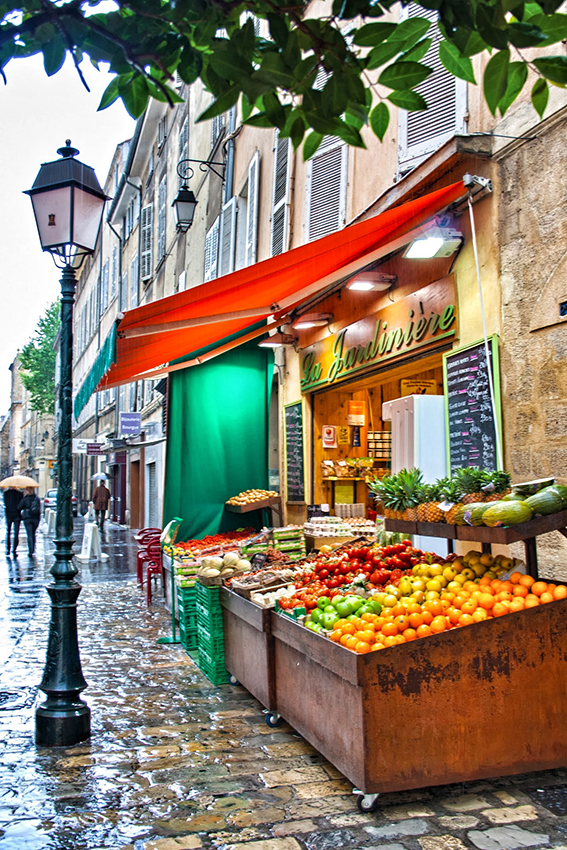
By the time I’d refuelled it had stopped raining – just in time for our departure from the city. The huge curtain of grey sky was drawing back, making way for a canvas of bright blue dotted with fluffy white clouds. I headed back along Cours Mirabeau, once again past its splashing fountains and towering sycamore trees, and the bar that no doubt held so many interesting stories from its past visitors. It was time to say ‘au revoir’ to Cézanne’s hometown.
Want to know more about Leger’s Highlights of Provence and the Dordogne tour? Click here.
Have you visited Aix en Provence? Share your stories and comments with us.
Florence: artistic treasures, amazing architecture and a rapidly-melting
The final city visit on our tour of the Italian Riviera, Tuscany and Rome was the Renaissance city of Florence, a city that was mentioned quite a bit in my art history lessons.
It was a warm and sunny day as we travelled into Florence, or Firenze as it’s known locally, heading firstly to a viewpoint high above the city. Florence sits in the valley of the River Arno and is surrounded by hills and mountains, and it was from the hilltop location of Piazzale Michelangelo that we were given an excellent view over the whole city with the rich terracotta dome of the cathedral’s mighty Duomo dominating the panorama. This is the shot that appears on many postcards so it’s the one to take for your album! Below us the River Arno ran past the pastel-coloured buildings and under the famous Ponte Vecchio which we could see over to the left.
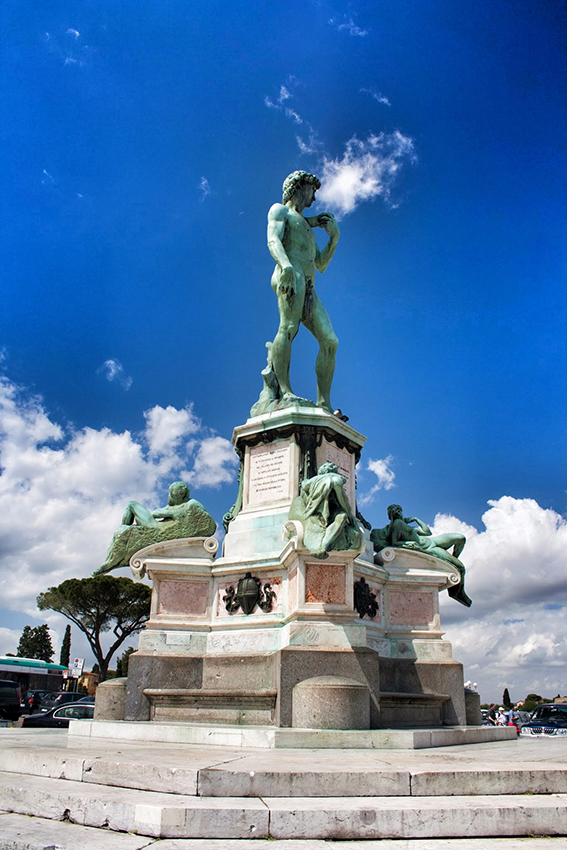
At Piazzale Michelangelo, along with many people taking photos and posing for pictures for their album, there was a replica of Michelangelo’s statue of David, one of the masterpieces of Renaissance sculpture. Apart from that, the square itself wasn’t much to look at – but we were there for the view and that was incredible! Once everyone had the photographs they wanted we headed down towards the centre to meet our guide who would introduce us to her city.
Florence was once surrounded by high defensive walls and towers, and the Tower of the Mint, (Torre della Zecca) which we walked past on our way into the city was part of those walls. This tower was once connected to a string of buildings which were powered by water, and one of these was the Florence Mint (Zecca fiorentina) where the city’s golden florins were made.
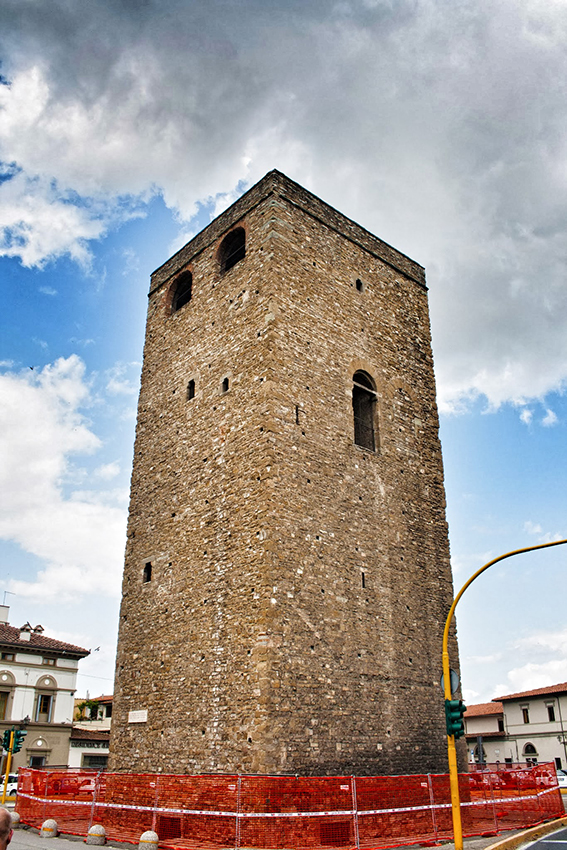
Our guide led us past the Mint Tower and along Via dei Malcontenti, a narrow street sandwiched between cream-coloured buildings. This was apparently the road that criminals were led along to the public gallows, and so it was given the name Malcontenti – ‘malcontent’ meaning unhappy.
After a while, after passing the Franciscan church of Santa Croce with its grand marble façade and weaving our way through the narrow streets of the city, we came out at the Piazza della Signoria, dominated by the huge bell tower; the belfry of the Palazzo Vecchio (Old Palace). This is the city hall of Florence and it was in front of the building that I spotted another reproduction of Michelangelo’s David, the most famous statue on the square. The real one, created in 1504, used to stand here but it was removed and placed in the Accademia di Belle Arti Firenze.
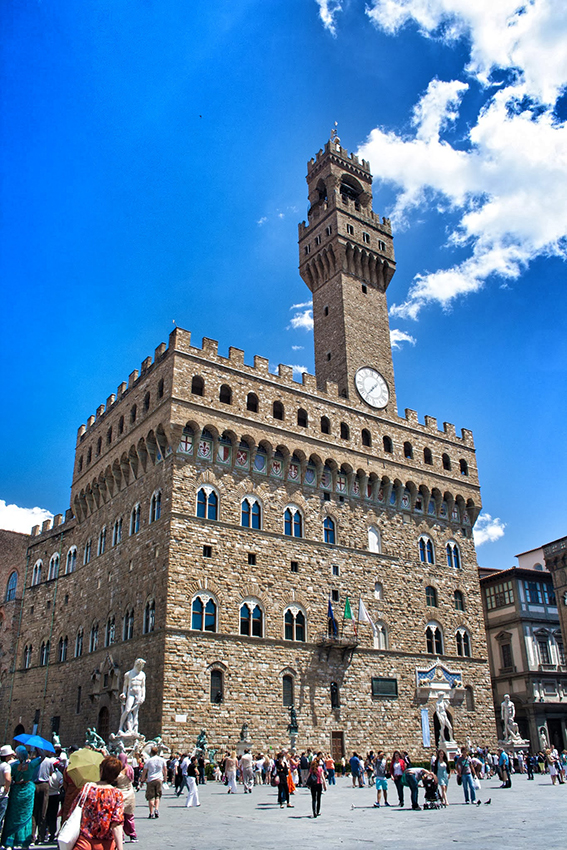
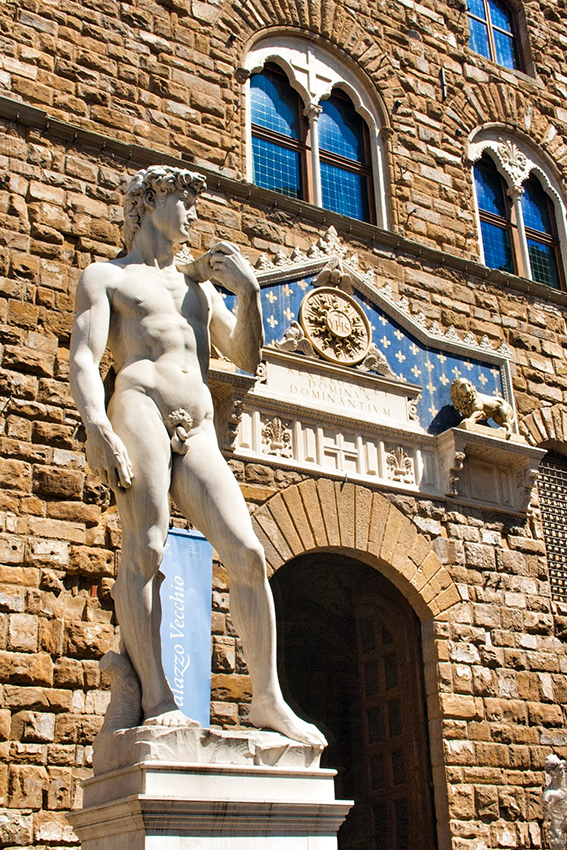
The square was buzzing with a great atmosphere – apparently it’s one of the most popular meeting spots for locals and tourists alike. Across from the city hall was the contrasting sight of designer stores being browsed by well-dressed shoppers and people strolling around trying to eat their colourful ‘gelato’ before it melted in the warm sunshine. Being a girl who doesn’t like shopping (yes, weird, I know!) I opted instead to join the gelato speed-eaters.
Frantically trying to keep the ice cream in its cone, I walked over to the large equestrian statue of Cosimo I de’ Medici standing just beside the city hall. Cosimo was famous for, amongst other things, the creation of the Uffizi which adjoins the Palazzo Vecchio and is now one of the most famous museums in the world, housing one of the greatest collations of art – most of it from the Renaissance period. Works by some of the greatest Italian artists are held here: names such as Michelangelo, Leonardo da Vinci, Botticelli and Giotto, again, names I remembered from the A-Level art classes of my school days. This was one place I would’ve loved to visit to bring to life all those paintings I’d studied in my text books… to see early works by Giotto; Botticelli’s Birth of Venus and Caravaggio’s Bacchus; all images I still remember. But it was time to move on.
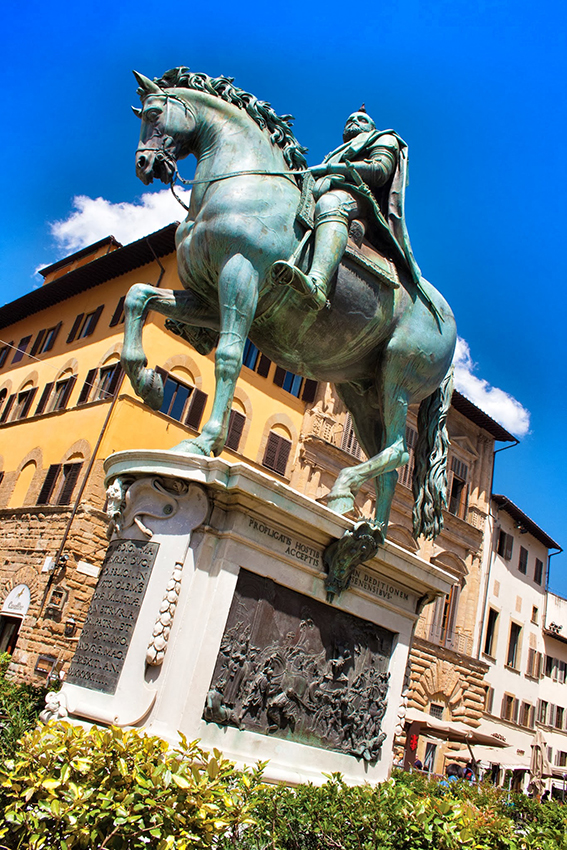
Our guide escorted us along the busy pedestrian street of Via die Calzaiuoli, home to many designer and high street names, a pizzeria here and there and quite a few places to buy those all important ice creams. The sweet smell of crepes and waffles led us along the alleyway until it opened up to reveal the breathtaking Piazza del Duomo. A couple of hours earlier we’d seen the huge domed roof of the Cathedral of Santa Maria del Fiore from the hillside across the river. Now we were up close, and it was truly magnificent.
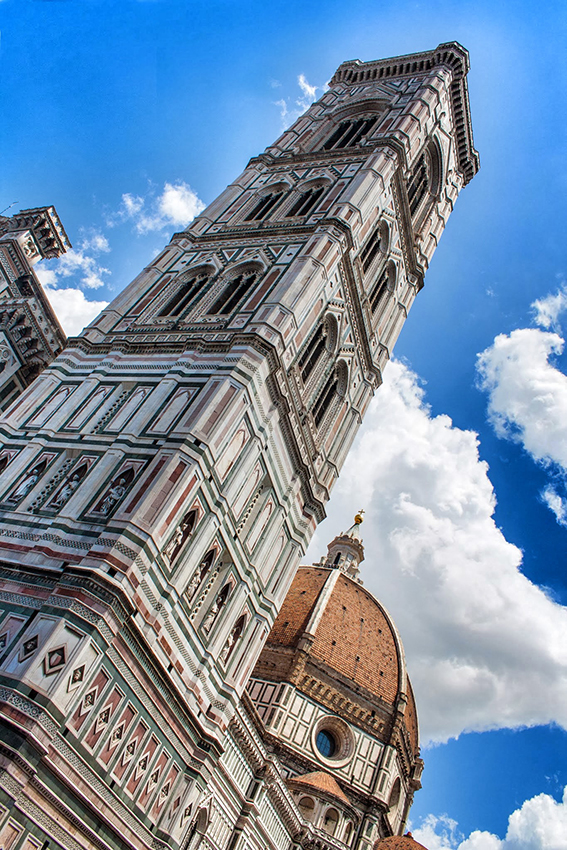
Right in front of us was the huge structure of Giotto’s Bell Tower. The column stands at almost 300 feet high and amongst its green, pink and white marble and displays intricate scenes. At the top, our guide advised us, the tower has 7 bells. We decided not to join the queues waiting to climb the 400+ steps to the top for a closer look and instead took her word for it.
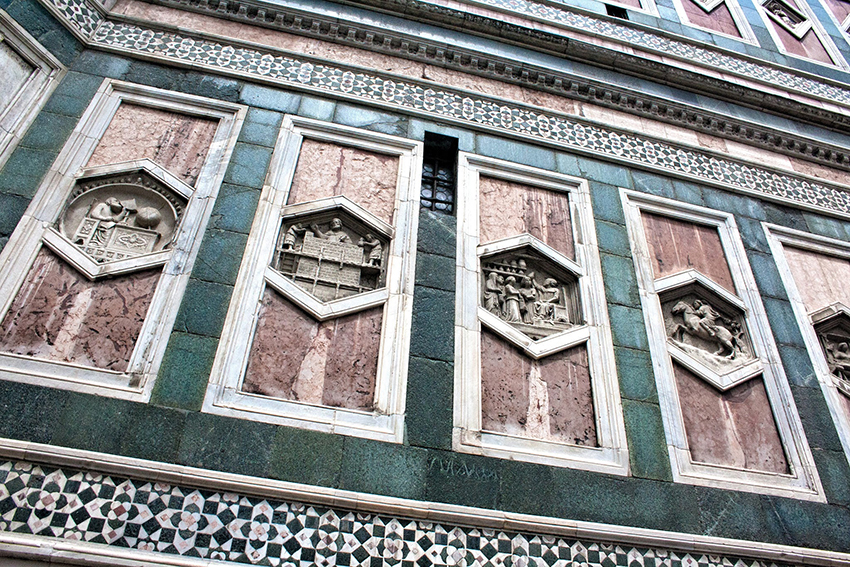
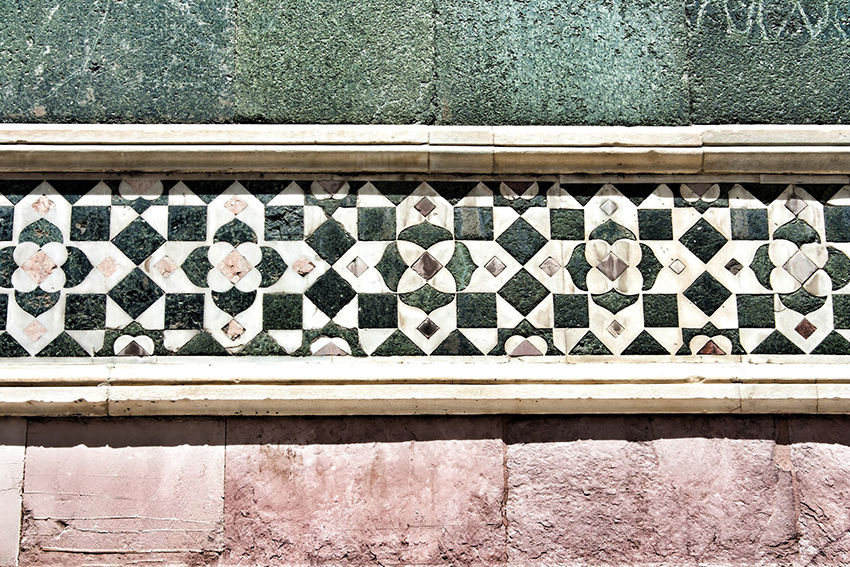
The Dome itself, designed and built by Filippo Brunelleschi, is equally impressive. More than 600 years after it was constructed the ‘Duomo’, as it’s known, still remains the tallest building in Florence. The cathedral is also the 4th largest in the world – the first is St. Peter’s in Rome, the second, St. Paul’s in London and the third, Milan’s Duomo.
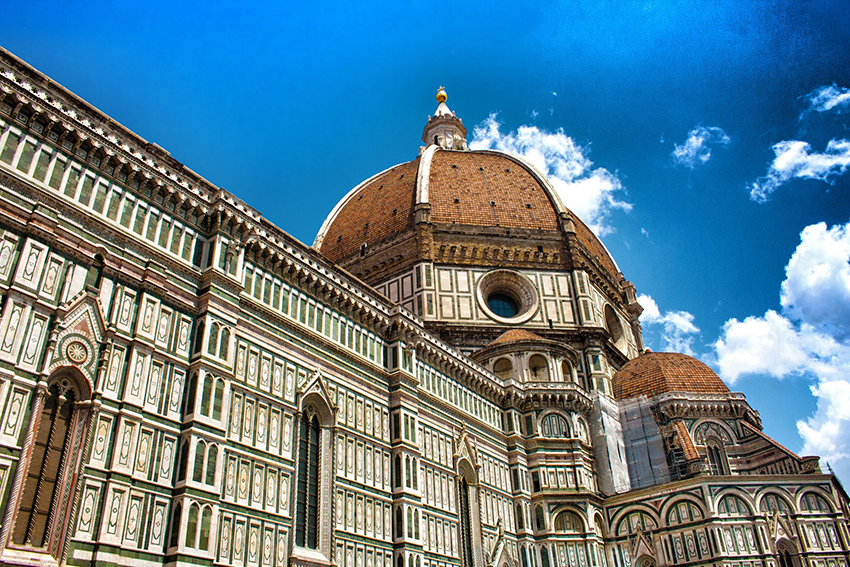
A short walk through the network of bustling passageways took us to the oldest bridge in Florence, the Ponte Vecchio. I’d seen photos of this bridge spanning the River Arno and always thought it looked rather plain, so I wanted to visit it for myself and find out why this well-known landmark is so popular.
The Ponte Vecchio was once the only bridge across the River Arno and the only bridge in Florence that wasn’t destroyed by Germans during WWII. Since the 13th century there have been shops on the bridge. Originally they housed fishmongers, greengrocers, butchers and tanners – the waste from which created a rather unpleasant smell in the river, so much so that in 1593 it was ordered that only jewellers and goldsmiths would be allowed to have shops on the Ponte Vecchio, making the bridge a much cleaner and attractive place to visit. Today, the bridge is still lined with jewellery stores attracting hundreds – probably thousands – of visitors each year.
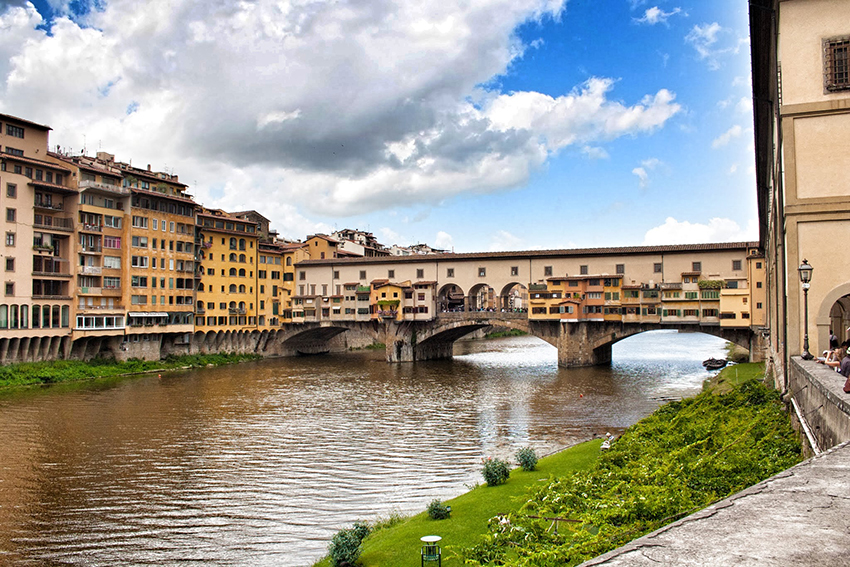
Approaching the bridge I saw the familiar sight of the construction and, even ‘in the flesh’, it struck me how ordinary it looked – a jumble of mustard and reddy-coloured buildings which looked as if they’d been stuck onto the main structure. As I got closer I could see just how ramshackle it appeared. Once on the bridge, however, it was a different story. The place had a great atmosphere and was brought to life by the crowds of people gathered around the stalls and the wares of the gold and silver smiths which twinkled in contrast to the dilapidated appearance of the bridge’s exterior.
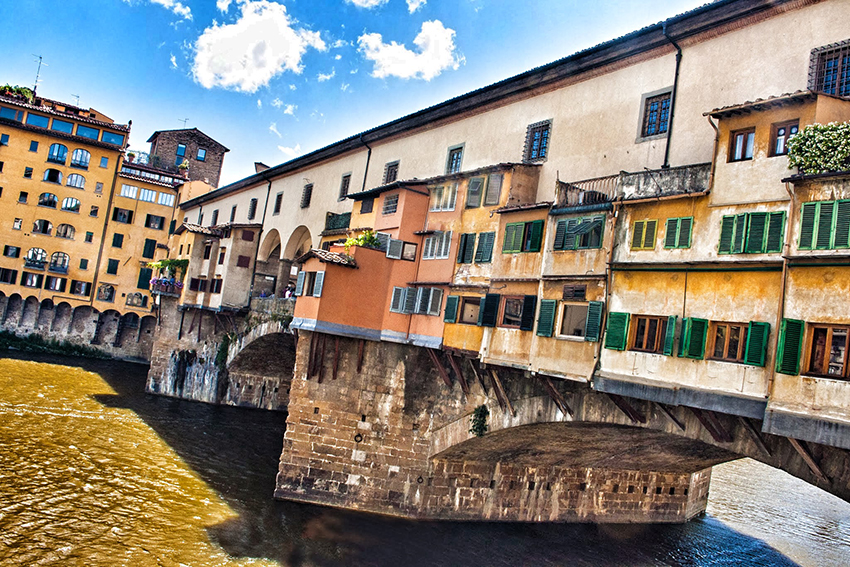
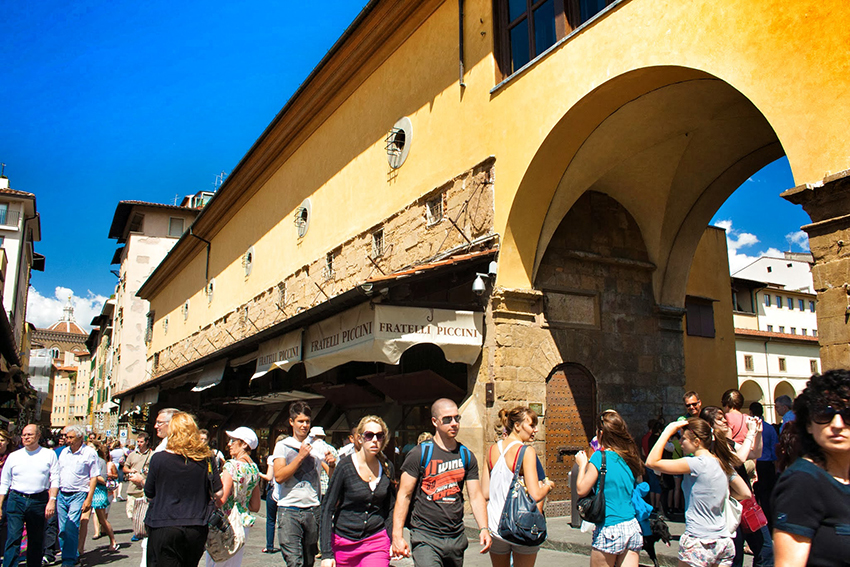
So, I can now say that I’ve visited Florence’s oldest bridge. It hadn’t contradicted my view of it as a rather plain and uninspiring landmark and I think there are much more impressive places to visit in the city, but I’d seen it for myself. The visit to Florence had given me a good overview of the capital of Tuscany, a brief history of the city and some of its landmarks, and of the sights I’d like to return to – namely the Uffizi Gallery.
Leaving the Ponte Vecchio and walking back along the Arno river, our visit to the Renaissance city had come to an end; another place to tick off my ‘must visit’ list… and another place I’d have to return to, one day.
Have you been to Florence? Share your stories and comments with us here!
Are you the UK’s biggest Christmas Scrooge?
Free holiday on offer for the UK’s biggest Scrooge
Are you the UK’s biggest Christmas Scrooge or does the thought of festive feelings bring you out in a rash? If so, you could be in for a treat with a twist this yuletide season!
We’re offering the nation’s biggest scrooge, and a friend of their choice, a free seat on one of our most popular Christmas Market tours in the hope of overcoming any Grinch-like ways they may have.
To enter yourself, or nominate a loved one, all you need to do is send us a 300 word explanation of what makes you (or the entrant) the UK’s biggest Scrooge along with a photo of the person nominated. Entries should be sent to losethescrooge@lucre.co.uk by the 25th of November 2013 at which point your entry will be put forward to the panel.
The lucky winner, who will be notified by the Leger team by the 27th November, must be available to travel on the 12th December 2013. Collected from one of a selection of pick up points, the winner and a companion of their choice will travel on a luxurious Silver Service coach to visit Brussels Christmas Markets and Valkenburg for a spectacular four day tour. Their Christmas spirit levels will of course be measured both before and after their return.
Huw Williams, Marketing Director for Leger Holidays said:
“The European markets offer unbeatable festive atmospheres which are sure to melt even in the frostiest of characters. Over the years, we’ve had so many customers come back from the tours claiming to have found a new sense of Christmas spirit that we just had to put this to the test and see how powerful the sights, sounds and smells of these markets can be!
“Of course, everyone is entitled to embrace their inner scrooge should they want to. However, through this competition, we wanted to provide an opportunity for those who are more curious about exploring their hidden Christmassy side. We look forward to reading through the entries and we wish everyone the best of luck!â€
Looking to enter or nominate someone you know? Make sure you’ve read our terms and conditions…
Terms and Conditions:
- The promoter is Leger Holidays Ltd. Sunway House, Canklow Meadows, Rotherham S60 2XR.
- The ‘Lose The Scrooge’ competition is open to all UK residents over 21 years old (including Northern Ireland, Eire and the Channel Islands) except for employees of the promoter, their immediate family and anyone else connected to the creation or administration of the promotion.
- The prize offered is non-transferable and is for one adult (over 21) and a travelling companion of their choice.
- The entry materials must belong to, or have had approval from, the entrant.
- The entry period is from 12th November 2013 until midnight on 25th November 2013.
- The overall winner will be announced by the 27th November 2013.
- The overall winner will receive two free seats on Leger Holidays’ Silver Service, four day tour ‘Brussels Christmas Markets and Valkenburg’. The tour includes three nights’ accommodation with continental breakfast (with the two travelers sharing a room one of whom must be over 21).
- No cash alternative is available and the tour must be taken on the 12th December 2013 as started, unless Leger Holidays announce otherwise.
- Please check at time of booking exact dates and times of travel, as missed departure will void the prize.
- Travel insurance is excluded. Winner should take out their own insurance.
- Entrants will be given a choice of collection points for the tour from a limited selection of areas presented by Leger Holidays. Travel costs to these points will not be covered by Leger Holidays.
- In the event of unforeseen circumstances, the promoter reserves the right to offer an alternative prize of equal or greater value.
- The judging panel’s decision is final and binding. No correspondence will be entered into.
- By entering this competition, entrants and any persons featured in the entry photograph agree that their nominations may be used by Leger Holidays as they wish, without prior notice to the entrant. Entrants will also have permission of all individuals in the photograph, as well as the permission of the copyright owner of the photograph, before entering the contest.
- Winners’ names and counties are available 28 days after the closing date. Send a SAE to Leger Holidays c/o Lucre, 30 Park Square West, Leeds, LS1 2PF.
- By entering the competition, entrants agree that their nominations and photographs/text/content will be posted on Leger’s social and media channels including the Leger Holidays website and blog.
- By entering the competition, the winner agrees to participate in any publicity involving print and broadcast media that is required.
- All text copy provided in this competition remains the copyright of Leger Holidays Ltd.
- By entering the competition, entrants agree to be bound by these rules and by any other requirements set out in the promotional material.
- Any inappropriate or offensive material will be reported to the police and removed from the competition.
- Leger Holidays may in its absolute discretion change these terms and conditions without notice or cancel the promotion without prior notice in the event of circumstances arising beyond its control that makes it necessary to do so. By entering this competition entrants are deemed to accept these rules.
Belgium Grand Prix with Leger Holidays – Neil Martin
Neil Martin (Daily Star) – Belgium Grand Prix press trip blog post
Many people who go to a Formula One event for the first time talk about the noise – but no-one ever seems to mention the deep rumble you actually feel in your chest.
It was certainly a shock to me at the Spa-Francorchamps circuit in Belgium as the cars came out onto the track for a practice session on Saturday.
Sitting just a few metres away on the bank beside the lightning-fast Kemmel Straight, the roar of the engines can make your whole body rattle.
So God only knows what it must feel like to strap yourself into the cockpit of one of those amazing machines, basically rockets with wheels, and blast down the track at more than 200mph.
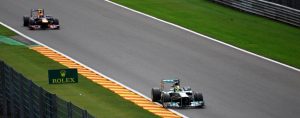
I’m not an obsessed F1 fanatic, but will watch the Grands Prix on television on a Sunday afternoon and follow who is doing well.
I was always interested, though, in knowing what it might be like to get up close to the action – and Leger’s three-night trip from the UK gave me the opportunity.
Spa is certainly a great place to experience everything that top-level motor racing has to offer.
Make sure you bring your hiking boots, though, as the circuit is nearly 4.5 miles long and extremely hilly as it winds its way through the Ardennes forest.
You’ll discover that immediately as you walk alongside the famous Eau Rouge corner that climbs steeply to a height of nearly 120 feet, about the size of a 13-storey building.
From there, you can walk all along the Kemmel Straight – the fastest part of the track – where drivers are able to put their foot right to the floor for more than 22 seconds to build up mind-blowing speeds.
At the highest point of Spa, pass through a tunnel underneath the circuit itself and walk downhill to the sweeping Pouhon corner that provides a natural amphitheatre for spectators.

From there you can weave your way out through the trees to the remote Stavelot corner, or go back below the track and then uphill again on the elevated pathway that runs parallel to the long Blanchimont section.
That will take you to the Bus-Stop Chicane, where the cars make a dramatic right/left swerve before crossing the finishing line.
And all of that was accessible with the general admission ‘Bronze’ ticket, included for Saturday and Sunday as part of the trip.
Best to wander around and see it all on Saturday, though, when the crowds are not quite as dense as they are for Sunday’s big race-day.
That’s when the real hardcore F1 petrol-heads get up bright and early to bag the very best spots to watch the action, getting their places by 6am as soon as the gates open.
And they come from far and wide with French mixing with Finns, Germans chatting to Spaniards and English alongside Italians – all cheering on their favourites when the race begins.
From our hotel in Antwerp we were coached the 100-mile journey down to Spa each day, arriving at around 10am.
Having walked around most of the circuit on Saturday and identified our favourite corners, it was heads down and straight to the location (Pouhon) on Sunday before luckily finding a few spare square feet of space to squeeze into.
Those who prefer to be a bit more civilised can upgrade to Silver/Gold tickets which guarantee a specific seat in a grandstand – and also offers the additional benefit of shelter from any rain which famously develops out of nothing around Ardennes.
On this occasion the wet stuff, which can really spice up the race as drivers battle to keep their cars on the track, stayed away on Sunday and Sebastian Vettel enjoyed a processional victory.
But that’s the beauty of live sport – you just never know what is going to happen – and being there in person was certainly a much different experience to watching on TV from the comfort of the living room.
For more information on any of our Formula One tours please visit our dedicated Formula One tour page.
Ideas for Father’s Day From Leger Holidays
A new car cleaning kit, baking a cake or a matching shirt and tie set are all very nice ideas but are they a little predictable? Why not take a look at our ideas for Father’s Day.
Many dads across the country would be over the moon with a car cleaning kit, but I was thinking this year I’m going to look at something a little more exciting. This father’s day I’m thinking outside the box something like a Formula One Grand Prix Weekend.
If your dad is anything like mine, then there is nothing he enjoys more than a weekend packed full of sport. Especially when the Formula One season starts. A big ambition of his is to go to a Formula One Grand Prix Weekend. Around this time of year is when the annual comments like “Next year we are going to go to Monaco” or “I would love to of been there for that race” make an appearance.
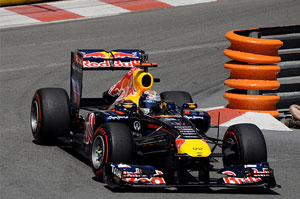
I know not all dads are the same. If a sporting weekend is not your dads’ cup of tea, maybe a Battlefield Tour would be more suitable? Our Battlefield tours are very popular amongst Leger customers. Especially in the build up to Father’s Day, a favourite amongst our customers is the All Quiet on the western front tour.
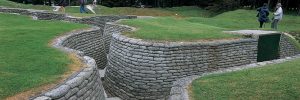
The Formula One Race Weekends and Battlefield tours are just a couple of ideas we suggest as ideas for Father’s Day gifts. Our website houses a variety of alternatives that maybe more suitable. There are tours that include city breaks, cruises, and many other live events including the Andrea Bocelli in Tuscany.
For more information on any of our tours or for more ideas for Father’s Day please visit our website. Alternatively you can contact our friendly reservations team on 01709 787 463.
Photo courtesy of Flickr user: Jim, the Photographer
The 60 year search – Jonathan and Douglas Ford
My great great uncle, Ernest Edward Ford, a Rifleman in the Kings Royal Rifle Corps, was killed at Passchendaele on 31st July 1917. For his efforts in the war, he was awarded the Military Medal for bravery in the field. In December 2011, I tracked down his campaign medals and the military medal. This brought to an end to the 60 year search involving both my father and I. Here is the full story.
The 60 year search started in the early 1950’s. My father, Douglas Ford was taken to Bawdsey Parish Church near Woodbridge in Suffolk, by his father, my grandfather. Whilst at the church he was shown a plaque on the wall commemorating those from the village who were killed in the First World War. One of those names was Ernest Edward Ford. My grandfather told my father that Ernest was his great uncle. My father was fascinated by this and wanted to find out more, so he talked to his Uncle, his father’s brother who had some information on the family history. He explained to my father that Ernest Edward had been awarded the Military Medal, however he did not know the whereabouts of the medals. He said to my father “perhaps you will find out one day what happened to the medals”.
My father was also interested to know whether Ernest Edward had a grave, and where it was. However, nobody in the family seemed to know. My father’s uncle did, however, state that he believed Ernest Edward had moved to Goole, and it was there where he had enlisted.
In the mid 1950’s, dad started training as a carpenter and joiner, and finished his apprenticeship in 1960. He began to travel in the UK and overseas in the construction industry. He had never lost his curiosity about the medals, and everywhere he travelled with work, he would put notices in shop windows, enquiring on the off chance that somebody might read them, who knew of their whereabouts. He also never walked past an antiques shop without going in to see if they had any medals, and would always inspect any medals they had in stock to see if they were Ernest Edward’s.
In the late 60’s, Dad moved to Wakefield in West Yorkshire and settled there. He continued to search for the medals over the coming years. He also wrote to the war office however they did not seem very forthcoming in those days with giving information out.
The search continued, and in the 1980’s, dad was told that, if he knew Ernest Edward’s service number, he might be able to obtain more information from the war office on the whereabouts of the grave and the medals. He also found out that Military Medal recipients were mentioned in the London Gazette. By this time, I had joined my dad in the research of his family history. We went to the reference library in Leeds, where we were shown a collection of London Gazettes that had been catalogued into books. The series from 1914 to 1918 filled a shelf. We were told that, somewhere in those books, Ernest Edward would be cited, along with his service number, however there was no way of knowing which book it would be in. We set about the daunting task of going through each book in turn. Dad started at one end of the shelf, and I started at the other, to see if we could find the information. Luckily, I found the citation in the second book I picked up. This was our first real breakthrough, as we now had Ernest Edward’s service number.
Dad then wrote to the Commonwealth War Graves Commission, they confirmed that Ernest Edward had enlisted in Goole, and they told us that Ernest Edward was commemorated on the Menin Gate at Ypres. At last we knew where his memorial was and that he didn’t have a known grave. However we still didn’t know what had become of the medals, and even with the additional information, the War Office would not shed any more light on it, saying only that the medals would have been released to the next of kin. But there was no sign of the medals in the family.
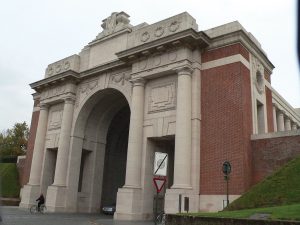
Now that we knew the whereabouts of the grave, we decided to visit Ypres, and hoped that we might find out some more about the medals. Our first visit to Ypres was for Armistice Day 2001. We visited the Menin Gate, and also spoke to lots of people to see if we could get any more tips on how we might continue the search for the medals, however we didn’t really get any further.
In around 2005, there was another breakthrough. One of dad’s cousins gave him a death plaque that had been issued to Ernest Edward’s mother . She had been in possession of it for some time and decided to give it to dad when she found out about his search for the medals. Dad decided to write to the war office again, stating that he was now in possession of the death plaque. He asked again if there was a record of who had received the medals after the war. The war office wrote back and said they would have been issued with the death plaque to the same person. We wondered if the medals had been in the family but maybe sold on.
At around the same time, we became aware that Leger Holidays ran trips to the Ypres Salient and heard of very good things about their battlefield tour guides. In 2006 we decided to return to Ypres, this time on a Leger Battlefield tour. It was then that we met Paul Reed and Keith Quibbell, who gave us lots of good advice on how we might move our search along, and also did some research on our behalf.
We continued searching for the medals over the next few years, but still could not find any trace.
In 2011, we visited Ypres again on a Leger tour, and one of the things that we learnt from that trip was how many war records were now being catalogued on the internet. On our return, I visited Ancestry.co.uk where I found some limited records for Ernest Edward. These records did not give us any more information though.
However, only a few weeks later, in December 2011, we had another big breakthrough. Another wave of war records had been loaded onto the internet site, including Ernest Edward’s. From those, we found lots more information, and, crucially, there was a document that stated that the beneficiary of Ernest Edward’s will was a Mrs Jackson in Goole. Not only that, but also there was a copy of a receipt, that confirmed these medals had been sent to Mrs Jackson, and not to the Ford family as the War Office had indicated. At last we knew where the medals had gone. My father and I discussed our next move, and decided that, in the New Year we would visit Goole, to see if we could track the Jackson family down, and to see if they had the medals.
Before that happened though, the last breakthrough came, and this one was the most astonishing. Over that preceding two years, I had periodically been doing internet searches on Ernest Edward Ford and Military Medals, to see if anything came up. Nothing ever had. However, just before Christmas I repeated the search, and there in front of me, on the computer screen, was a copy of an auction catalogue from Warwick and Warwick auction house. Within that catalogue was one lot, for E E Ford – Military Medal, Victory Medal and British War Medal. I had finally found the medals. There was one snag though, the auction had taken place that day, it seemed the medals had most probably been sold, and maybe lost forever. I spoke to dad about it, and undeterred, dad then phoned the auction house the next day. The auction house told us that the medals had been in a private collection for some 50 years; however the collection had recently been opened up, to be auctioned. They also told us that Ernest Edward’s medals had been sold to a dealer, Dixons medals in Bridlington. Dad then phoned Dixons, and spoke to the proprietor, Chris Dixon. On finding out that the medals had been awarded to our ancestor, and hearing the story of our search, Chris immediately agreed to sell them to us, for a discounted price, and without offering them to the open market. We were so relieved and so grateful at how sympathetic Chris had been towards us. On December 21st 2011, dad and I travelled to Bridlington, where we picked up the medals from Chris Dixon. Finally, the search had come to an end, and for the first time ever, the medals were in the possession of the family.
We could not believe that we had the medals, but what astonished us more, was some of the coincidences in the story. Firstly, Ernest Edward had grown up in East Anglia, and moved to Yorkshire before the war where he settled. Dad commented on how he had also grown up in East Anglia and settled in Yorkshire. Secondly, the medals had also made their way to Yorkshire after the auction. They seemed destined to come to us.
If there’s one message that we would like to give to other people who might be in the same position of not knowing where their ancestor’s medals are – that message would be to never give up. After nearly 60 years of a search which seemed like a search for a needle in a haystack, we have the medals back where we feel they belong.
If you are interested in any of the battlefield tours we offer, please visit our website Leger Battlefield Tours.
New Tour – Bohemian Rhapsody – Delights of the Czech Republic
Here at Leger Holidays we have just unveiled a new holiday, Bohemian Rhapsody – Delights of the Czech Republic Tour.
This Tour allows our customers to explore the highlights of the Czech Republic, including the capital Prague ‘City of 100 Spires’. We also include excursion to many spa towns of the western Bohemia and not forgetting the Baroque treasure if Cesky Krumlov in southern Bohemia.
The 9 day break includes some truly amazing places. We also offer the chance to visit the popular spa resort of Karlovy Vary. There are twelve hot thermal springs all of which are still in use. The town is also known for its hand-made glass. A recommendation whilst there is to visit the famous Moser glass factory.
The following day includes a visit to the second largest spa town in the Czech Republic, Marianske Lazne. Time is provided for you to take in the immaculate gardens before continuing on to the fortress town of Cesky Krumlov.
Cesky Krumlov is a UNESCO World Heritage Site and is nestled on the banks of the Vltava River. In the centre of the medieval city there are many well preserved buildings and stunning architecture. To guarantee customers see the very best of Cesky Krumov there will also be an optional city tour available.

Our tour also visits the home of Budweiser beer, Cesky Budejovice better known as ‘Budweis’. The tour continues on to Tabor; Czech Republic’s most favourite tourist spot.
Before heading back to Belgium and completing your return leg of your holiday we visit Prague. This excursions includes a guided walking tour of the ‘Golden Town’. The walk introduces our customers to the splendid architecture of Prague Old Town. The huge castle is a must along with a relaxing drink in Wenceslas Square.

For more information or to book this tour, please visit our Bohemian Rhapsody – Delights of the Czech Republic Tour page.
Ever visited the Czech Republic? We would love to hear about your travels in the comment sections below.
The Chelsea Flower Show
With the Chelsea Flower Show getting underway next week, I thought I’d take a look at the history behind this annual event and have a look at what attracts so many visitors year after year.
The Chelsea Flower Show is held in the grounds of the Royal Hospital Chelsea in Chelsea, London. The show was formally known as the Great Spring Show, and is known as the most famous flower show in the UK attracting visitors from all over the world.
The flower show was first held in Chelsea in 1912, as a one off event but as the location was such a success it has stayed there almost every year since.
The show has up to 157,000 visitors each year, and all tickets must be bought in advance. The duration of the show was originally four days but from 2005 onwards it was increased to five. Members of the Royal Family attend a preview day each year as the royal patronage of the RHS (Royal Hortical Society).
There are five award categories at the event. They are:
Flora – Gardens and floral exhibitions
Hogg – Exhibits of Trees
Knightian – Exhibits of vegetables, including herbs
Lindley – Exhibits of special educational or scientific interest
Grenfell – Exhibits of Pictures, photographs floral arrangements and floristry.
Other awards are known as the Special Awards, which include Best Show Garden Award, Best City Garden Award, RHS Junior Display Trophy and many more.
The Chelsea Flower Show is included on our Chelsea Flower Show, Henley and Oxford Tour, for more information or to book your place for next years event please visit our website.
If you have been to the show before, we would love to hear your experience please leave your comments section below.

